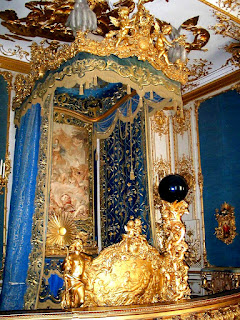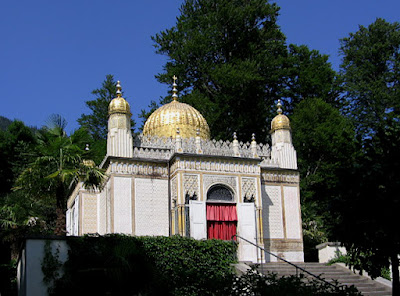SCHLOß LINDERHOF
Schloß Londerhof
Linderhof Palace (German: Schloss Linderhof) is in Germany, near Oberammergau in southwest Bavaria near Ettal Abbey.
It is the smallest of the three palaces built by King Ludwig II of Bavaria and the only one which he lived to see completed.
Atlas Sculpture - Schloß Linderhof
Schloß Linderhof - Fountain
The water parterre in front of the castle is dominated by a large basin with the gilt fountain group "Flora and puttos". The fountain itself is nearly 25 meters high.
Schloß Linderhof at Night
Schloß Linderhof - Plan
Linderhof Castle is an ornate palace in neo-French Rococo style, with handsome formal gardens.
Just north of the palace, at the foot of the Hennenkopf, the park contains a Venus grotto where Ludwig was rowed in a shell-like boat on an underground lake lit with red, green or "Capri" blue effects by electricity, a novelty at that time, provided by one of the first generating plants in Bavaria.
In the forest nearby a romantic wooded hut was also built around an artificial tree (see Hundinghütte above).
Inside the palace, iconography reflects Ludwig's fascination with the absolutist government of Ancien Régime France.
Ludwig saw himself as the "Moon King", a romantic shadow of the earlier "Sun King", Louis XIV of France.
From Linderhof, Ludwig enjoyed moonlit sleigh rides in an elaborate eighteenth century sleigh, complete with footmen in eighteenth century livery.
He was known to stop and visit with rural peasants while on rides, adding to his legend and popularity.
The sleigh can today be viewed with other royal carriages and sleds at the Carriage Museum (Marstallmusem) at Nymphenburg Palace in Munich.
Its lantern was illuminated by electricity supplied by a battery.
There is also a Moorish Pavilion in the park of Schloß Linderhof.
Schloß Linderhof - State Bedroom
Schloß Linderhof - State Bedroom
Schloß Linderhof - Salon
Schloß Linderhof - Salon
Schloß Linderhof -Ludwig's Private bedroom
Schloß Linderhof - Peacock
Schloß Linderhof - Gardens
Schloß Linderhof - Garden Temple
Schloß Linderhof - Maurischer Kiosk
This building was designed by the Berliner architect Karl von Diebitsch for the International Exhibition in Paris 1867.
Ludwig II wanted to buy it but was forestalled by the railroad king Bethel Henry Strousberg. Ludwig bought the pavilion after the bankruptcy of Strousberg.
The most notable piece of furniture of this building is the peacock throne.
Schloß Linderhof - Maurischer Kiosk
Schloß Linderhof - Maurischer Kiosk
Schloß Linderhof - Maurischer Kiosk
Schloß Linderhof - Maurischer Kiosk
Schloß Linderhof - Maurischer Kiosk - Interior
Schloß Linderhof - Maurischer Kiosk - Interior
Schloß Linderhof - Maurischer Kiosk
The Peacock Throne
Schloß Linderhof - Venusgrotte
The building is wholly artificial and was built for the king as an illustration of the First Act of Wagner's "Tannhäuser".
Ludwig liked to be rowed over the lake in his golden swan-boat but at the same time he wanted his own blue grotto of Capri. Therefore 24 dynamos had been installed and so already in the time of Ludwig II it was possible to illuminate the grotto in changing colours.
Schloß Linderhof - Venusgrotte
Herrenchiemsee is a replica (although only the central section was ever built) of Louis XIV's palace at Versailles, France, which was meant to outdo its predecessor in scale and opulence - for instance, at 98 meters the Hall of Mirrors is a third longer than the original.
The palace is located on the Herren Island in the middle of the Chiemsee Lake.
Most of the palace was never completed once the king ran out of money, and Ludwig lived there for only 10 days in October 1885, less than a year before his mysterious death.
It is interesting to note that tourists come from France to view the recreation of the famous Ambassadors' Staircase.
The original Ambassadors' Staircase at Versailles was demolished in 1752.
Schloß Herrenchiemsee
Schloß Herrenchiemsee
The unfinished Neues Schloss (New Palace) was designed by Christian Jank, Franz Seitz, and Georg von Dollmann and built between 1878 and 1885.
Between 1863 and 1886 a total of 16,579,674 Marks was spent constructing Herrenchiemsee. An 1890 '20 Mark' gold coin contained 0.2304 troy ounce (7.171 g) of gold. Therefore, 16,579,674 Marks would equate to 190,998 oz of gold.
Ludwig only had the opportunity to stay within the Palace for a few days in September 1885. After his death in the following year, all construction work discontinued and the building was opened for the public.
In 1923 Crown Prince Rupprecht gave the palace to the State of Bavaria.
Schloß Herrenchiemsee - Spiegelgalerie - (Hall of Mirrors)
Schloß Herrenchiemsee - Ambassador's Staircase
Schloß Herrenchiemsee - Ambassador's Staircase
Schloß Herrenchiemsee - Spiegelgalerie - (Hall of Mirrors)
Unlike the medieval design of Neuschwanstein Castle begun in 1869, the New Palace is, in a sense, a Neo-Baroque monument to Ludwig's admiration of King Louis XIV of France.
In the great hall of mirrors of the palace the ceiling is painted with 25 tableaux showing Louis XIV at his best.
It was to have been an equivalent to the Palace of Versailles, but only the central portion was built before the king died in 1886, where-after construction was discontinued leaving 50 of the 70 rooms of the palace incomplete.
It was never meant to be a perfectly exact replica of Versailles and in several places surpasses it.
With a length of 98 m (322 ft) and 23 arches the Hall of Mirrors is larger than the Versailles equivalent.
The dining room features an elevator table and a huge chandelier of Meissen porcelain, the largest in the world.
The building also benefits from nearly two centuries of technological progress, while the original Versailles palace did not have a single toilet and the only running water was outside in the fountains.
King Ludwig's "copy" has more modern facilities including a central heating system and a large heated bathtub.
Schloß Herrenchiemsee - Gardens & Fountains
Also, unlike Versailles, it was built on an island and is now only accessible by a small ferry.
The formal gardens are filled with fountains, a copy of the Versailles Bassin de Latone and statues in both the classical style typical of Versailles and in the fantastic style typical of romanticism that was favored by King Ludwig. Cool maidens which look as if they have stepped out of a museum of classical antiquity are never too far from dragons, winged warriors, giant lizards and other extravagant beings which look as if they have come from one of Richard Wagner's romantic operas.
The formal gardens are filled with fountains, a copy of the Versailles Bassin de Latone and statues in both the classical style typical of Versailles and in the fantastic style typical of romanticism that was favored by King Ludwig. Cool maidens which look as if they have stepped out of a museum of classical antiquity are never too far from dragons, winged warriors, giant lizards and other extravagant beings which look as if they have come from one of Richard Wagner's romantic operas.
Adolf Hitler visiting Schloß Herrenchiemsee
c1930s
Adolf Hitler visiting Schloß Herrenchiemsee
Wappen Freistaat Bayern
Bavaria, formally the Freistaat Bayern (Free State of Bavaria), is a state of Germany, located in the southeast of the country.
With an area of 70,548 square kilometres (27,200 sq mi), it is the largest German state by area, forming almost 20% of the total land area of Germany.
Bavaria is Germany's second most populous state (after North Rhine-Westphalia) with almost 12.5 million inhabitants, more than any of the three sovereign states on its borders.
Bavaria's capital is Munich.
One of the oldest states of Europe, it was established as a duchy in the mid first millennium.
In the 17th century, the Duke of Bavaria became a Prince-elector of the Holy Roman Empire. The Kingdom of Bavaria existed from 1806 to 1918, and Bavaria has since been a free state (republic).
Modern Bavaria also includes parts of the historical regions of Franconia and Swabia.
Bavaria is renowned for its beautiful alpine scenery, which forms a superb backdrop for the magical castles built by the former King, Ludwig II.
for more information see
a fascinating, fully illustrated study of this
truly remarkable period of modern history
truly remarkable period of modern history
click here for 'Parsifal'
Richard Wagner's greates music drama
this blog is under construction - please be patient
for the art of Peter Crawford go to


























































































